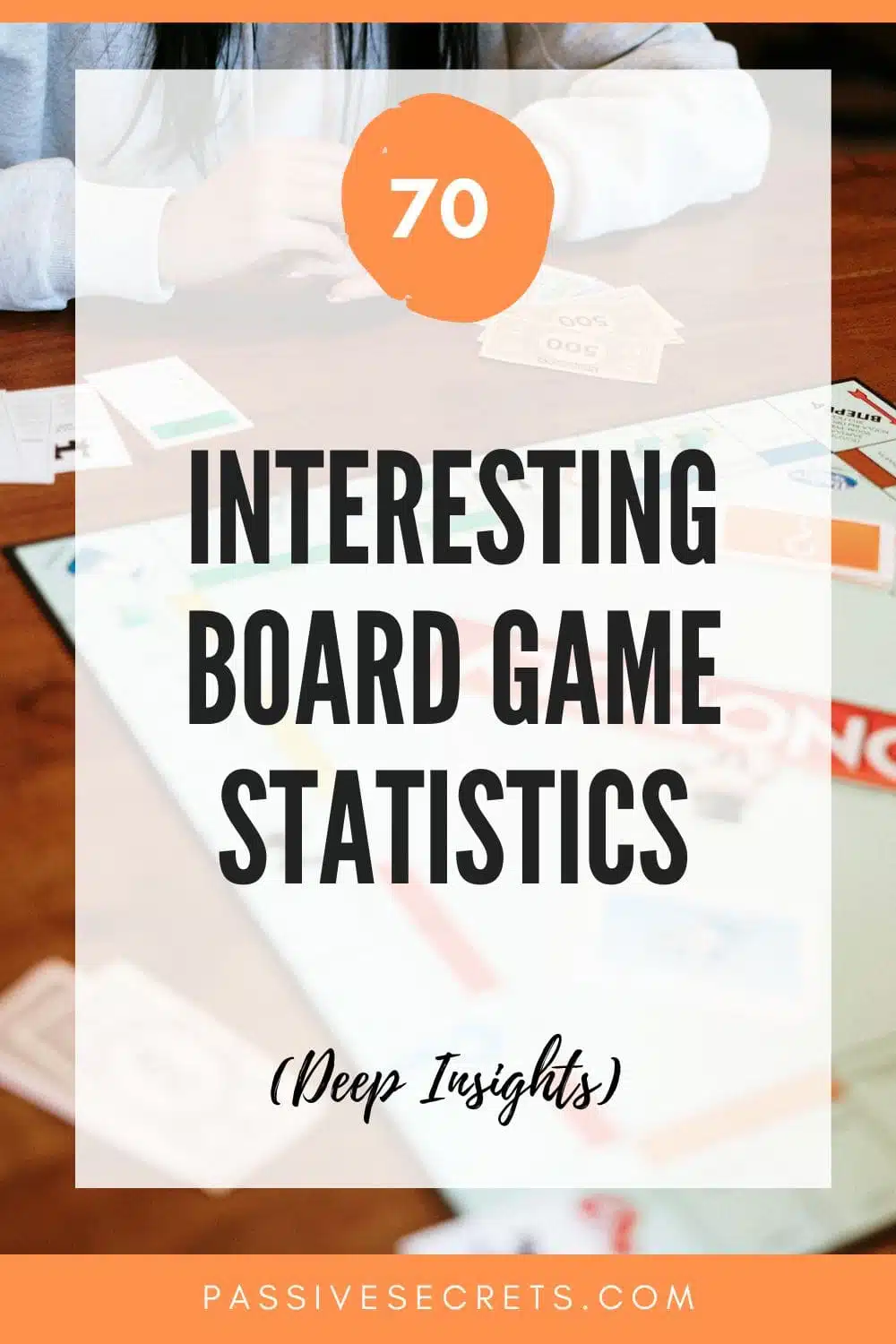
Did you know that around 5,000 new board games are released yearly?
Board games are simple and relaxing table games in which people get together, roll dice, move pieces, and try to win. They have been around for a long time and have gained even more popularity in recent times.
This is because board games have proven to be extremely versatile and offer a plethora of benefits.
Playing board games tests your critical thinking skills and challenges the brain in many creative ways.
Over time, these games have undergone refining and re-packaging, so there is now a modern way to enjoy board games.
They come in various types, including strategy games, card games, war games, and party games catering to different interests and ages.
In this article, we will share interesting board game statistics, from revenue to market size, demographics, and the most popular board games in the industry.
Key Board Game Statistics
- The global board game market was expected to generate $9 billion in revenue in 2024.
- The projected revenue per capita for each person playing Card Games in 2024 is a modest $0.37.
- The revenue in the global Card Games market is predicted to continue growing, reaching $3.27 billion by 2028.
- The global board game market is expected to increase from $13.06 billion in 2023 to $32.00 billion by 2032.
- North America is the top global board games market, occupying a significant share of 28.88%.
- In the United States, around 72% of women and 59% of men said they enjoyed board games.
- Gen Z (38%) enjoys board games more than the Silent Generation (29%).
- There are over 20,000 board game publishers, as well as 150,000 board games and associated items available.
- Monopoly is the best-selling modern board game of all time, selling 275 million units.
General Board Game Statistics
1. One-fifth of the world’s population (19%) counts playing board games or cards as a hobby. (source)
2. Each year, around 5,000 new board games are released. (source)
3. Board game enthusiasts are more likely to indicate they prefer to see real-looking individuals in advertisements (62% versus 57%). Gamers, on the other hand, are significantly more likely to say they love viewing advertisements with their favourite celebrities (46% versus 42%). (source)
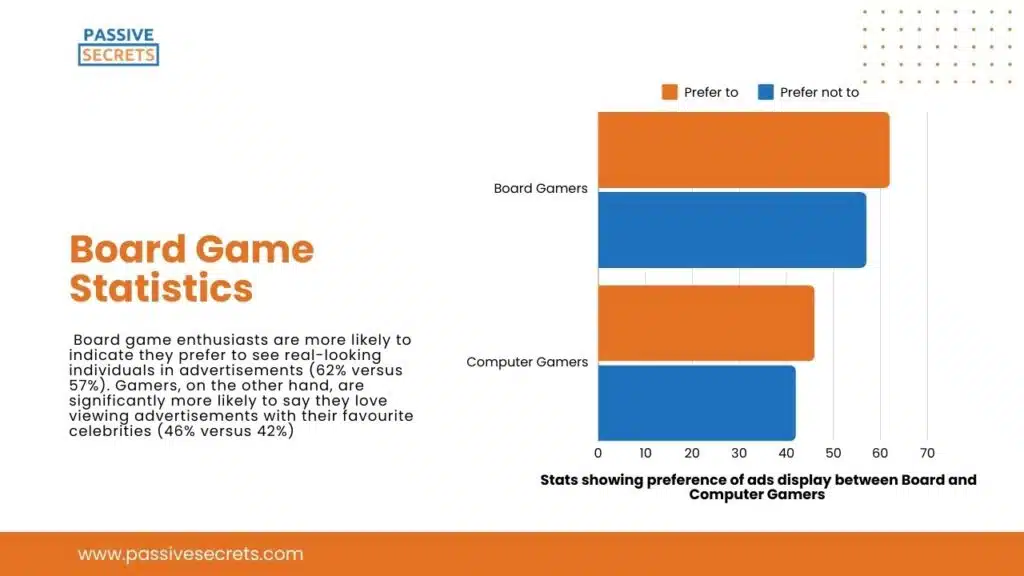
4. Games Workshop, a well-known name in the tabletop gaming industry, operates a vast network of stores worldwide, with the United Kingdom boasting the highest number of stores at 135. (source)
5. The classic board game genre can be broadly categorized into four distinct types: race games, space games, chase games, and displacement games. These categories encompass a diverse range of popular and historically significant titles. (source)
6. Senet, one of the oldest known board games, has been unearthed in archaeological sites and depicted in ancient Egyptian art, dating back to the First Dynasty of Egypt in 3100 B.C. (source)
7. Board games have certain benefits, such as bringing people together, strengthening relationships, and meeting new people. (source)
Board games increase brain function and teach people to set goals and be patient. They are also great for reducing stress as they create more happiness.
8. Board game cafes are quite common in Western European countries such as the UK, France, and the North American region. (source)
9. Interest in board games surged to an all-time high in March 2020, as Google Trends data revealed that searches for ‘board game’ reached their peak in March 2020, surpassing all other months since data collection began in 2004. (source)
10. The United States was responsible for more than 50% of global “Pandemic” game searches and over 40% of all “board game” searches worldwide. (source)
Board Game Revenue Statistics
11. The global board game market was expected to generate $9 billion in revenue in 2024. (source)
The revenue is set to grow at a CAGR of 3.52% from 2024 to 2028. In terms of revenue per person, the figure for 2024 is $1.11.
12. The United States generates the most revenue for the board game market, with $2.7 million projected for 2024. (source)
13. Among all regions, the United States stands at the forefront in terms of revenue generation for Card Games, with a projected revenue of $858 million in 2024. (source)
14. The projected revenue per capita for each person playing Card Games in 2024 is a modest $0.37. (source)
15. In-app purchases were projected to generate $981.30 million in revenue for the board game market in 2022. (source)
16. Paid app revenue in the Board Games market was projected to hit $50.47 million in 2022. (source)
17. Advertising revenue in the board game market was expected to reach $1,087.00 million in 2022. (source)
18. The average revenue per download in the board game market was estimated at $0.44 in 2022. (source)
19. The revenue in the global Card Games market is predicted to continue growing, reaching $3.27 billion by 2028, with a projected increase of $0.4 billion (14.04%) from 2024 to 2028. (source)
20. The forecasted revenue per capita of the ‘Card Games’ segment of the global toys & hobby market is set to increase by 10.81% from 2024 to 2028, reaching a new peak of $0.41. This upward trend follows nine consecutive years of growth in this sector. (source)
Board Game Market Size Statistics
21. The global board game market is expected to increase from $13.06 billion in 2023 to $32.00 billion by 2032, at a CAGR of 10.52% over the forecast period. (source)
22. The ‘Card Games’ segment of the global toys & hobby market is dominated by the United States, with a revenue of $817.7 million in 2024. (source)
China ranks second with a revenue of $408.16 million, while India holds the third position with a revenue of $31.1 million. These figures highlight the wide disparity in market sizes across different regions.
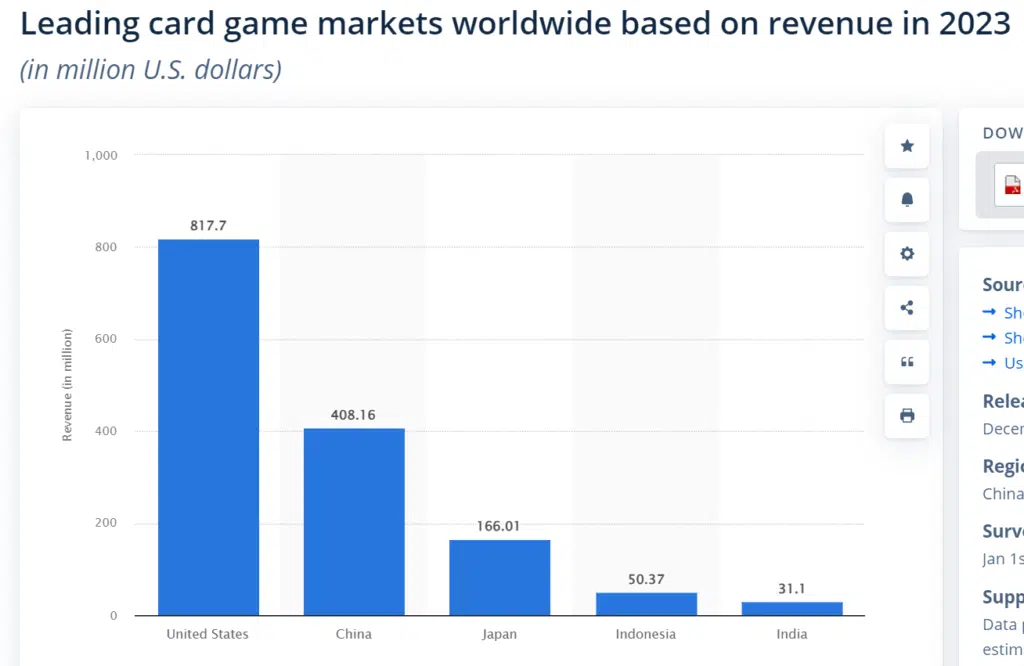
23. An analysis of board game spending reveals that the majority of consumers invest at least $100 annually, with 22% spending more than $1,000 and 41% spending between $100 and $1000. (source)
24. The global chess market has been expanding steadily, with North America leading the way, forecasted to reach a market value of $40.5 million in 2022. (source)
25. The global market value of cards and board games was estimated to be around 12.02 billion U.S. dollars in 2018. This market is forecast to reach a value of 21.56 billion U.S. dollars by 2025. (source)
26. The tabletop game industry saw an increase in crowdfunding success in 2020, reaching a total of over $233 million in campaign earnings, up from $176.3 million in 2019 – an impressive growth of 32% in just one year. (source)
27. The global board games market is on the rise, with an estimated compound annual growth rate (CAGR) of 7.55% from 2022 to 2027, leading to an increase of USD 3.42 billion in revenue. (source)
The board games market thrives due to numerous factors, including improvements in-game content and mechanics that enhance players’ overall gaming experience.
28. The tabletop game segment has witnessed consistent growth over the years, reaching a value of $3.65 billion in 2017. (source)
It is driven by the continued popularity of traditional board games like Scrabble and Checkers, as well as sports-based games such as cricket, football, and carrom.
29. Board games have emerged tremendously from the challenges of modern life, addressing concerns like mental health and electronic device addictions. (source)
30. Europe is poised to contribute significantly to the growth of the global board game market, responsible for an estimated 32% of overall market growth. (source)
31. Board games are enjoyed by a vast majority of the population in the United States, with 44% finding them “very enjoyable,” while only 11% consider them “not very enjoyable.” (source)
32. The global board games market is forecasted to expand at a Compound Annual Growth Rate (CAGR) of 13.27% between 2022 and 2028. (source)
33. Puzzle and tabletop games are the two dominant segments in the global board games market. (source)
Puzzle games had more than USD 6.9 billion in revenue and a market share of over 50%, while tabletop games follow closely with a market share of 23%.
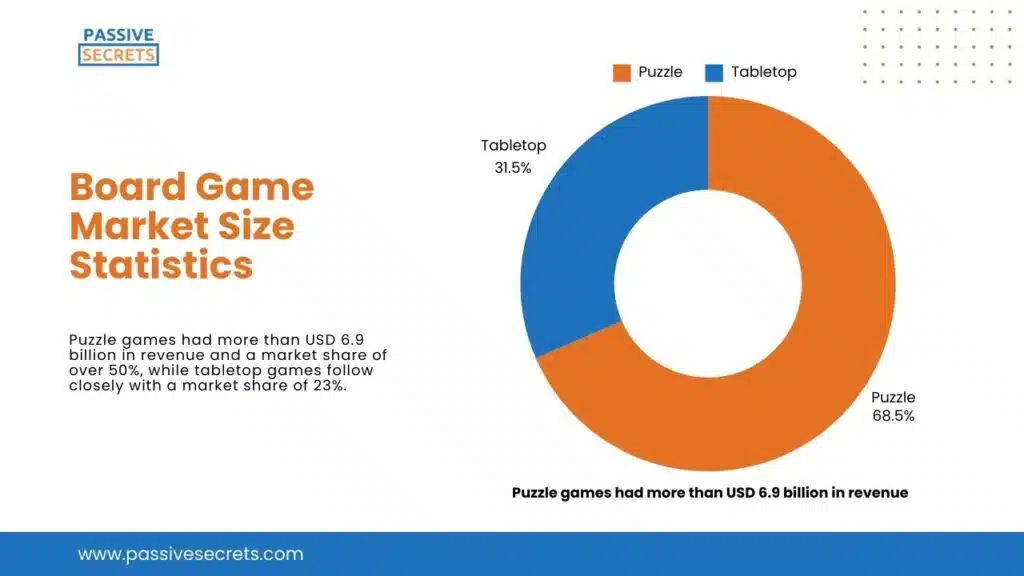
34. The educational board games segment dominated the global board games market with over 41% share owing to the higher penetration of puzzles among end-users. (source)
35. The traditional offline segment dominated the global board games market in 2022 with a significant market share of 54%. (source)
However, the increased availability and accessibility of the Internet have altered the board game market landscape, as more players are turning to digital platforms.
36. The online board games market is experiencing high demand in the US, as well as Germany and the UK, leading to a projected Compound Annual Growth Rate (CAGR) of over 13% from 2022 to 2028. (source)
37. North America is the top global board games market, occupying a significant share of 28.88%, driven by its unique board games that differ from those found in Europe. (source)
38. The board games market grew to US$16.8 billion in 2023 and is expected to expand at a CAGR of 9.81% from 2024 to 2032, reaching a size of US$40.1 billion by 2032. (source)
39. The board game market analysis reveals that North America is the dominant region, commanding the largest market share, while Asia Pacific, Europe, Latin America, the Middle East, and Africa are significant regions for growth and opportunity. (source)
40. The ‘Puzzles’ segment of the toys and hobby market is dominated by the United States, which brings in about $922.82 million in revenue, followed by China with $375.22 million. (source)
Meanwhile, India comes behind, recording a revenue of $30.63 million, highlighting a revenue gap of $892.19 million to the United States.
41. The worldwide Card Games market is expected to earn around $3 billion in revenue by 2024. This shows how popular card games are as a form of entertainment. (source)
42. The Card Games market is projected to experience a steady annual growth rate of 3.50% annually from 2024 to 2028. (source)
Board Game Statistics by Demographics
43. Approximately 47% of individuals who prefer playing board games or cards are between the ages of 18 and 34. They make up 57% of the gaming population. (source)
People aged 55 and older, on the other hand, account for nearly twice the size of the board game cohort (18% vs 10%).
44. In the United States, around 72% of women and 59% of men said they enjoyed board games. (source)
45. Women are fairly represented in the board game audience (51% versus 49% of men), yet they account for only two-fifths of the gaming population (39% vs 61%). (source)
46. The popularity of board games is widespread across generations, with 65% of Baby Boomers and 66% of Millennials in the United States saying they enjoy board games. (source)
47. Gen Z (38%) enjoys board games more than the Silent Generation (29%). (source)
48. Belgium has the largest share of board players, with the United States coming in second at 23% (compared to 33% of gamers). (source)
Board Game Playing Frequency Statistics
49. The frequency of board game play among enthusiasts ranges from daily to less than monthly, with 43% playing at least a few times per week, 6% playing daily, and 3% playing less than monthly. (source)
50. Over half of the survey respondents (57%) have supported a board or card game on either Kickstarter or Indiegogo, with Kickstarter being the most popular choice for backing campaigns (90%), while Indiegogo has a smaller presence in the crowdfunding space. (source)
51. A survey of individuals in Canada reveals that while only 3.1% of respondents play board games daily, a significant number of people engage in this pastime on a less frequent basis. (source)
Board Game Statistics on Gamers’ Playing Habits
52. The number of downloads in the Board Game Market was estimated at 4.85 billion in 2022. (source)
53. The distribution of board and card game ownership among respondents is largely concentrated in the lower ranges, with 57% owning between 1 and 25 games and 22% owning between 26 and 50 games. (source)
54. However, a small but significant group of passionate players owns more than 50 games, with 4.2% owning between 51 and 75 games, 5.9% owning between 76 and 100 games, and a notable 10.9% owning over 100 games. (source)

55. 41% of gamers purchase 5-10 new games or expansions per year, indicating a relatively frequent level of engagement. (source)
27% of gamers purchase more than 30 games each year, which highlights the presence of a subset of highly engaged enthusiasts. At the same time, 35% of gamers who purchase 4 or fewer games each year represent a group with a relatively less frequent level of engagement with the hobby.
56. Many board gamers (59% of respondents) turn to Amazon for their game purchases, and the local game store remains a critical point of purchase. (source)
Additionally, 41% of respondents rely on Kickstarter as a source for new board games, indicating a significant level of interest in crowdfunded projects within the hobby.
57. Surprisingly, 71% of respondents say they hear about new games through word-of-mouth. Other common responses included browsing BoardGameGeek, Kickstarter, and Amazon, as well as attending conventions. (source)
One of the less popular answers was online advertisements, with just 17% of gamers hearing about new games through this channel.
58. A data summary reveals that home environments (40%) and local game stores (33%) are the top two locations for board game enthusiasts to enjoy their hobby, while alternative locations, such as cafes/bars or conventions, also serve as popular hubs. (source)
59. More than half (58%) of survey respondents always play board games with friends or acquaintances, while 37% usually do so. (source)
These figures reveal the social aspect of the hobby, as 95% of participants prefer to play with others rather than alone.
60. When it comes to family members, almost half (48%) of players usually or always play with family, showing how board games can help strengthen family bonds. (source)
On the other hand, 28% of players rarely or never play with family members, suggesting that not everyone views board games as a family activity.
61. Board games can help people make new friends, as 41% of players sometimes play with people they don’t know. However, 10% of players would rather stick with their close friends or family. (source)
Most Popular Board Game Types
62. There are over 20,000 board game publishers, as well as 150,000 board games and associated items available. (source)
63. Monopoly is the best-selling modern board game of all time, selling 275 million units. It has sold 1.83 times more copies than Scrabble or Clue. (source)
| Title | Copies Sold | Year of Origin | |
|---|---|---|---|
| 1. | Monopoly | 275 million | 1935 |
| 2. | Scrabble | 150 million | 1938 |
| 3. | Clue | 150 million | 1949 |
| 4. | Battleship | 100 million | 1931 |
| 5. | Trivial Pursuit | 100 million | 1981 |
| 6. | The Game of Life | 70 million | 1960 |
| 7. | Rummikub | 55 million | 1950 |
| 8. | Candy Land | 50 million | 1949 |
| 9. | Cranium | 44 million | 1998 |
| 10. | Othello | 40 million | 1883 |
64. The top 6 sites for playing board games include Board Game Arena, Yucata, BrettsPielWelt, Tabletopia, Boite a Jeux, and Happy Meeple. (source)
65. Scrabble is the most searched-for game in terms of search popularity, particularly in French-speaking countries. Per capita, French-speaking islands Martinique and Reunion searched it the most, followed by France, Senegal, and Canada. (source)
66. Monopoly, a favourite across Asia and Europe, was a clear second in terms of worldwide popularity. This was because the game has been reproduced in 103 countries and 37 different languages. (source)
67. The top 5 best-selling board games of all time include; Chess, Checkers, Monopoly, Scrabble, and Clue. (source)
Chess sells more than 3 million units yearly in the US, checkers has sold about 50 billion since it was introduced, Monopoly sold more than 275 million units, and Scrabble and Clue sold more than 150 million units.
68. Monopoly is the undisputed champion of board games, with an impressive 500 million players worldwide, earning it a Guinness World Record and solidifying its place as the most popular board game in history. (source)
69. When it comes to card games sold on Amazon in Mexico, Unstable Unicorns: Nightmare is the most popular game, retailing for 391.80 Mexican pesos. (source)
Then Dominó Doble 6, Virus, and 5 Segundos para Ganar follow suit, all of which feature in the top 10 list of most popular games on the e-commerce platform in Mexico.
70. As online gaming platforms continue to gain popularity, card games are experiencing an increase in interest in countries like the United States and Canada. (source)
Players can now enjoy their favourite card games without leaving home, connecting with others, and improving their skills.
FAQs
1. What are the key regions in the global board games market?
The key regions in the global board games market are North America, the Middle East, and Africa.
2. What are the key factors driving the global board games market?
The key factors driving the global board games market are their ability to induce critical thinking, problem-solving, and team-building capacity.
3. What are the three most popular board games worldwide?
The three most popular board games are Monopoly, Chess, and Pandemic.
4. What are the top three easiest board games to play?
The top three easiest board games are Goose games, Roll-and moves, and Snakes and Ladders.
5. Who are the key players in the global board games market?
The key players in the board games market are Goliath games, Buffalo games, Clementoni Spa, and Franckh-kosmos.
Conclusion
Board games are more than just a fun way to pass the time.
They are a vibrant, diverse, and growing form of entertainment that brings people together, challenges the mind, and fosters a sense of unity.
Whether you’re a casual player or a dedicated enthusiast, board games offer an engaging and enjoyable experience for all.
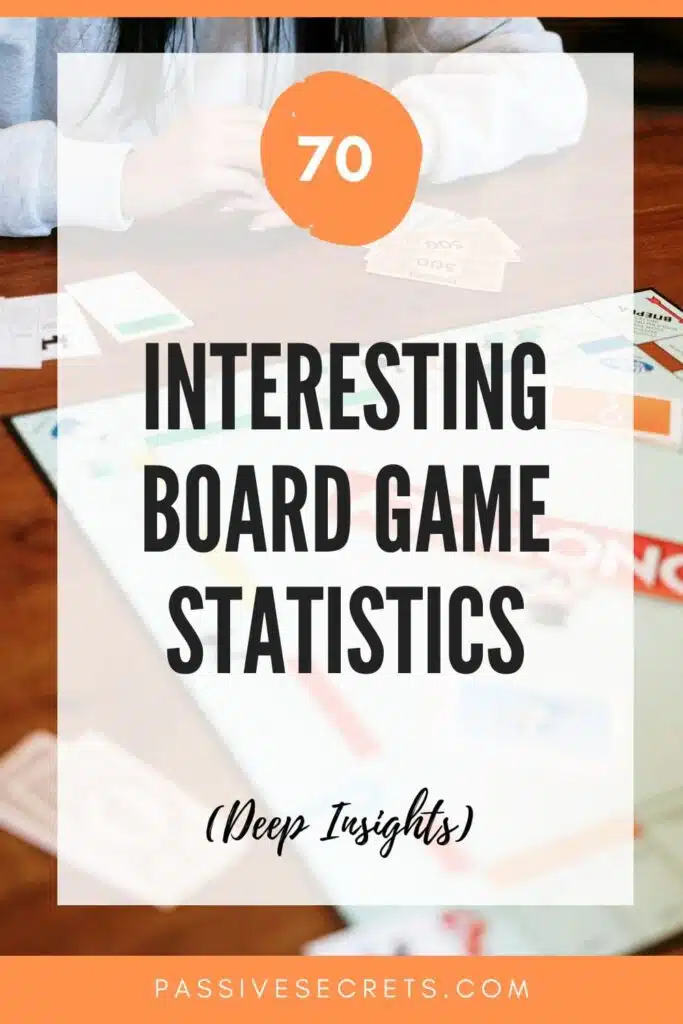
Related Posts:
- Thought-Provoking Gender Inequality Statistics: 160+ Insights Across Regions
- 110+ Shocking Income Inequality Data You Need to Know
- 50 Interesting Sharing Economy Statistics You Need to Know
- 100+ Animation Statistics: The Ultimate Guide To The Industry’s Trends and Insights
- 80+ Franchise Statistics and Facts You Should Know In 2024
- The Future of Learning: 50+ Top EdTech Statistics For 2024
- The Web3 Statistics Report 2024: Trends, Insights, and Predictions
- Meme Statistics 2024: Facts, Trends, and Figures That Will Blow Your Mind
- 85+ MOST Interesting Anime Statistics and Facts (NEW Report)
- 125+ Interesting Airbnb Statistics by Country (Deep Insights)
- 50+ Interesting Born Into Poverty Stay In Poverty Statistics
- 90+ Interesting Film Industry Statistics (NEW Report)
- 80+ Alarming Technology Addiction Statistics You Must Know
- 65+ Impressive Chess Statistics and Facts To Know in 2024
- Spotify Statistics: Latest Report on The Music Streaming Platform
- 50+ Useful Video Game Addiction Statistics, Facts & Huge Trends
- 50+ Vital Internet Safety Statistics & Facts You Must Know
- Internet Dangers Statistics: A Look At The Internet’s Dark Side
- 50 Interesting Bible Statistics and Facts You Didn’t Know
- 95+ Interesting Dream Statistics and Facts You Can’t Miss
- 75+ Interesting Relationship Statistics & Facts You Should Know
- Dance Statistics: A Deep Dive Into The Rhythm Of Movement
- 40+ Incredible Single Father Statistics You Have to Know
- The Battle of the Sexes: Male Vs. Female Spending Statistics
- 95+ Jaw-Dropping Period Poverty Statistics You Need To Know
- 70 Exciting Love Statistics And Facts (True Love, Intimacy, Marriage, Dating & Relationships)
- 30+ Gentle Parenting Statistics & Facts: Is This Parenting Style Worth It?
- 55+ Useful Black Consumer Spending Statistics (2024 Report)
- Holiday Spending Statistics: Valentine’s Day, Easter, Thanksgiving, & Christmas

